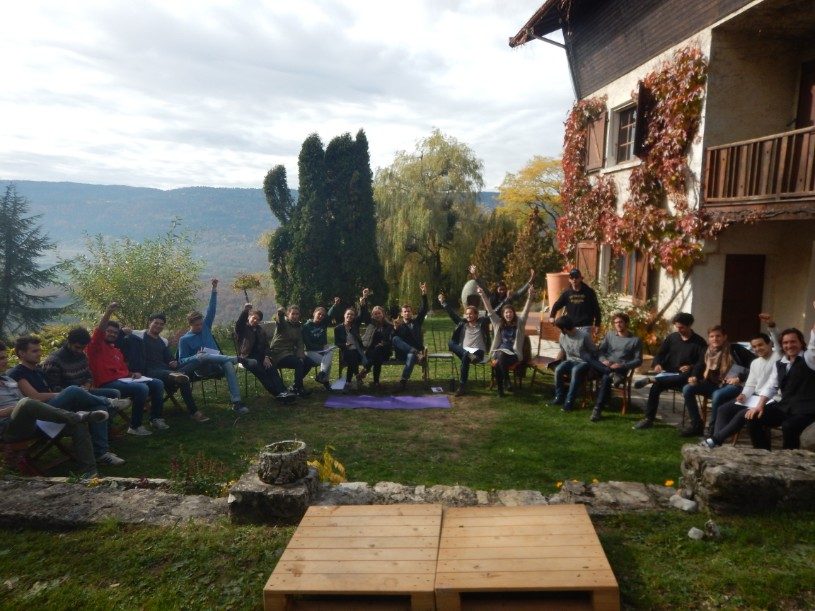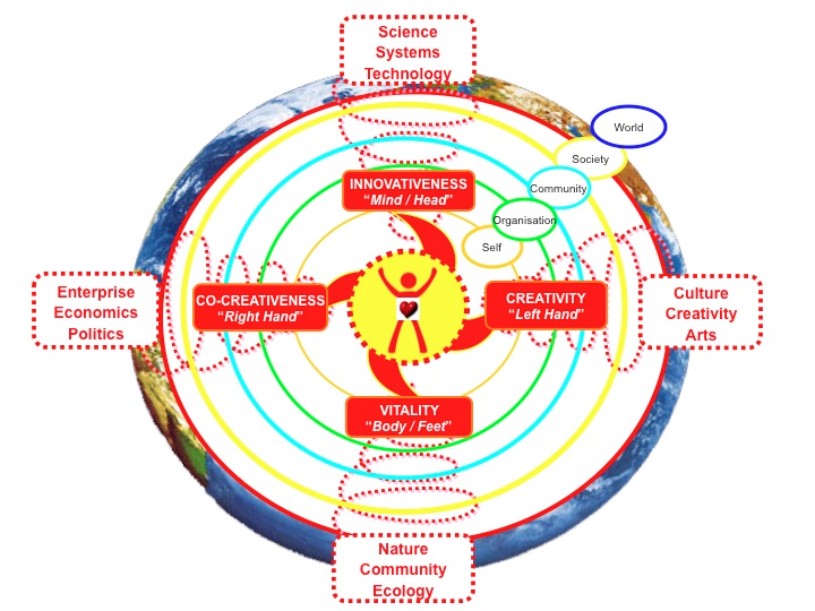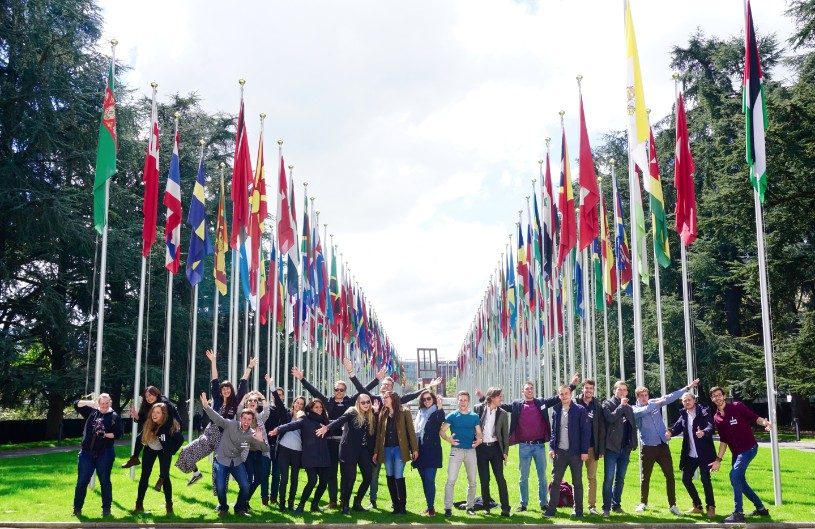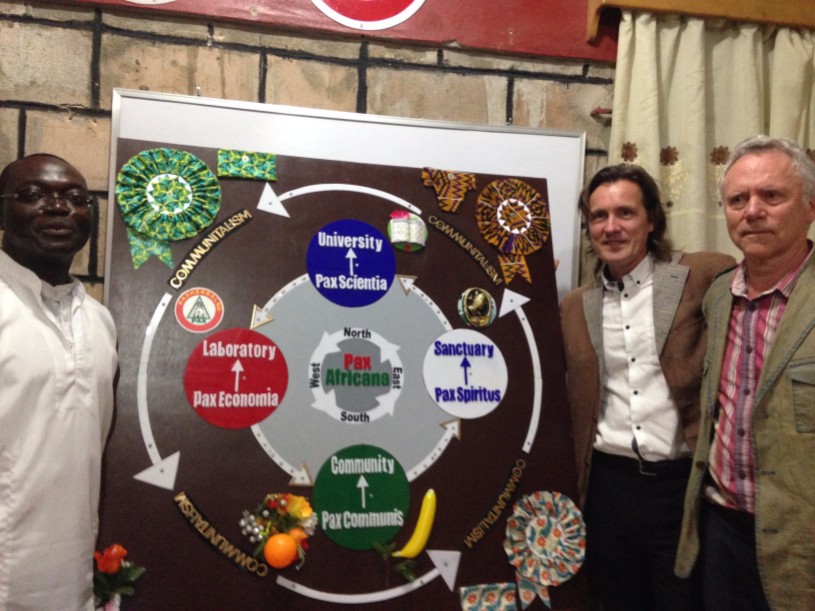Imago Integralis: The Aesthetics of Integral Life
I. Longing for the Integral Life
This article introduces a new integral perspective on life and provides clues of what it might mean to live life as a contribution to the cultural renewal, aesthetic unfolding, and holistic development of self and society, community and institutions, people and planet.
It is rooted in over a decade of developing, together with Ronnie Lessem and a growing network of global co-creators, the Integral Worlds approach with numerous applications worldwide. Despite many successes, we witness a growing urge, need, and longing to move further beyond a cognitive understanding towards full-fledged ‘enlivenment’ and embodiment of integral life. We begin with a brief review on ‘life’ and on ‘integral.’
On Life:
Life is indivisible! There is only ‘one life’ permeating creation. Personal development cannot really be looked at in isolation but only as ‘integral’ to life as a whole. Life is neither insular nor static. It is in continuous evolutionary unfolding, operating on the principle of ‘interdependent co-arising’—a term borrowed from Jean Houston. Life engages all human and non-human systems, animated and unanimated matter alike, in a ‘great play’ of continuous co-learning and co-evolution. In this highly relational process, we need to transcend our current ‘modus operandi’ based on exploitation, control, and dominion towards a holistic, nurturing, and caring attitude to life. Such a perspective ‘re-embeds’ humanity within creation and moves us to participate in life’s ‘great dance’ so that our own individual wholeness flourishes in unison with all life on the planet. Gradually, humanity is opening up to a holistic paradigm, aspiring to rebalance and reintegrate all that we are from within ourselves (body, mind, heart, soul, etc.) and all that we are from without (nature, culture, science, economics, etc.).
The Emergence of the Integral Age:

Recent decades showed an intensive engagement with integral philosophies and models. The works of Ken Wilber and Don Beck stand out, though there are many related thinkers and practitioners activating the ‘integral field.’ All of them are a continuation of a centuries-long if not millennia-long quest for a more integrated understanding of life. In more recent history, this quest was pursued, for example, by Henri Bergson, Sri Aurobindo, and Jean Gebser. In fact, it was Gebser who claimed in The Ever Present Origin that after the archaic, magical, and mythical state, humanity is currently in the last sparks of an overripe mental state. He predicted that the crucial next step is to transition into the integral state, integrating and transcending all prior states.
What all of these integrative perspectives have in common is the attempt to reconnect hitherto fragmented perspectives on life and to give voice to the evolutionary urge of the human species to evolve towards higher levels of convergence. Teilhard de Chardin articulated this longing as humanity’s move towards a so-called ‘Omega Point.’ In summary, one may well coin humanity’s next era the ‘integral age’—and our own Integral Worlds approach is to be seen in this context.
On Trans4m’s Integral Worlds Approach:

Ten years ago, Ronnie Lessem, my Zimbabwean-British colleague, son of Jewish immigrants from Eastern Europe, and I, born into post-Nazi Germany, established our Trans4m Center for Integral Development. What brought us together was our shared passion to counterbalance the growing cultural, economic, ecological, and political injustice worldwide via an integrated theory and transformative practice. Since then, we have established the Integral Worlds approach as a new philosophy and practice to address burning issues in our societies and catalyze integral solutions.
By ‘integral’ we mean a dynamic ‘whole life’ perspective that:
• integrates the development of self, organization, community, society, and world
• includes all aspects of a living system including nature, community, and ecology; culture, creativity, and arts; science, systems, and technology; enterprise, economics, and politics; altogether connected by an inner core
• draws on local and global knowledge and is particular to the natural, cultural, scientific, and economic life of any given context
• is geared to bring about holistic solutions with local relevance and global resonance to restore ‘dynamic wholeness’
This understanding is reflected in Figure 1.
Ode to Integral Life
my little bucket
is about to break
you poured yourself
so totally
into my heart
that I can’t hold
my self together
any longer
allow my cup
to burst into your stream
and as I join your waters
grant me union
with your all-abundant glory
The starting point for bringing forth any new integral solution is always the individual transformation agent. Whether they join our university-accredited PhD process, which we call a ‘Process for Holistic Development,’ or enroll in a tailored transformational journey, each of these agents follows an inner calling that, in turn, needs to echo with the challenge perceived by his or her organization, community, and/or society. Such a matching between personal inner calling and collective outer challenge is vital for the formation of an innovation ecosystem within the organization that supports the individual agent and for the activation of the shared transformative potential.
By now, the Integral Worlds approach has been richly developed. It has been applied to enterprise, community, economics, development, research, and many other fields. Our active network of transformation agents and centers grounded in this integral approach stretches from Nigeria to Zimbabwe, from Sri Lanka to India, from Brazil to Paraguay, from Jordan to Egypt, from Slovenia to Australia, and beyond. Together, we have addressed a wide range of burning issues like famine and food insecurity, disability and discrimination, chronic unemployment, violence against women, divided religious communities, and dysfunctional economic systems. In response, in a co-creative process with our local partners, we have generated culturally-rooted integral solutions from integral community development to financial inclusion; from creating an integral enterprise to an integral national economy; from empowering women to developing grassroots leadership processes. Together, we have achieved some extraordinary results.
Indeed, the journey has been rewarding for many, testifying that breakthroughs are possible even in countries plagued with conflict, like Zimbabwe, Nigeria, and Sri Lanka, or deeply divided like Brazil and India—when they are locally grown, culturally rooted, and innovatively integral.
However, working within transitional or industrialized countries, and working with institutions, businesses, and universities, we notice how great the resistance to change still is. It remains difficult to sustain change and turn innovative initiatives into fully embodied personal and institutional practices. The pull of old patterns is overwhelming. More often than not, people remain caught in fear, doubt, egocentrism, conflict, overactive mental processes and many other predicaments. Despite real progress, we are still ‘stuck in ego’ rather than ‘flourish in eco.’
II. ‘Imago Integralis:’ A Blueprint for Embodying Integral Life
The next step for the integral age is to embody the integral perspective more fully—make it a living reality in our own lives so that it can become sustainable in our organizations and societies. Then it can grow into an ever-evolving ‘whole life ecology.’ Let’s begin with a short exercise.
Tuning Into ‘Whole Life Ecology:’
Let’s get up, stretch our arms and legs as far as we can in all directions, up and down, backward and forward; jump high and lie down, continuing the same exercise; get up again and turn around on our axis, embrace all we are within ourselves and everything around us. We begin to receive a physical and most likely also emotional sense for a fully rounded existence. Indeed, we have enacted huge circles and we have connected with all directions. We are in touch with ourselves and the world. We may feel like a four-petalled flower, rooted in the earth, rising towards the sky, fully opening up, and offering the sight and fragrance of our fully-rounded, blooming blossom to everyone, including ourselves. We have tasted ‘whole life ecology.’

On the Inner Aesthetics of an Integral Life:
Through this exercise, we have also tuned in with ancient blueprints. The cultural root images in almost all civilizations depict round, fourfold representations of a whole life: from the Tibetan Mandala to fourfold cosmotheandric designs of First Peoples; from the Celtic Cross to the Buddhist eightfold Wheel of Life; from the cosmology of the Bakongo People in Africa to calligraphic representations of the Prophet Mohammed’s name, to mention but a few. All of these highly aesthetic circular representations provided visual, spiritual, and philosophical guidance of what it means to live life in tune with oneself, with humanity, with earth, with cosmos. For all civilizations, such images played a most important role. They imprinted an ‘imago of the ultimately possible,’ served as a ‘living life compass,’ and spurred the imagination for crafting a ‘full-filling’ life. However, in transitional times like ours, many of these civilizational root images and philosophies are losing their original power for collective orientation. Therefore, we are now called to engage in inner processes that allow us to (re)connect with an authentic ‘imago’ of a whole life—an image that vibrates with our innermost aesthetics. Such an ‘imago integralis’ of who we are and can become—Jean Houston calls it the ‘optimal quantum blueprint’—is what many of us long for.

Towards an ‘Imago Integralis:’
Living an Integral Life would require us to formulate this aesthetic ‘imago integralis’ of our optimal self and move towards it by co-evolving five key qualities: vitality, innovativeness, creativity, co-creativeness, and, most importantly, love. Each of these ‘integral qualities’ has a personal and a transpersonal dimension. All of them form an integral part of our ‘imago integralis’ (intimated in Figure 1) for a fully rounded, wholesome life; it is itself ‘alive,’ actively expanding into ever-larger co-creative and co-participatory spaces. As we integrate all five qualities and embody fully our ‘imago,’ gradually our personal life has an increasing impact on the holistic development of our social systems: our family, community, organization, society, and world.
South = Body = Vitality:
We begin with the body, as our physical form is our initial and first ‘access point’ to life. In order to live a strong purposeful life, we need to have our ‘feet on the ground,’ be ‘in touch with’ body and earth, be able to listen to our bodily intelligence, exercise and attend to our body, nourish it well and
keep it healthy. If we strike the right balance, there is vitality within us, providing a foundation for all other qualities. Our own vitality, in turn, contributes to the vitality of life in general. It is through our body’s vitality that we experience our all-important relationship to nature and develop that lifelong bond with the ecology we are born and raised in. It is through our body that we feel and experience relationship, with ourselves and with others. We become aware of ourselves as ‘part of’ a larger body and we feel called to not only care for ourselves, but for all of creation.
North = Mind = Innovativeness:
The mind is the seat of thoughts and speech. The more we learn about the functioning of the brain, about how our thinking constructs our (usually rather limited) take on reality, about how our thoughts often push us, against our will, from self-inflation to self-dismissal, the more we fathom how important it is to learn how we think and know and how we can healthily groom these capacities. Furthermore, the more we grasp how thoughts shape reality, the more we develop insights into the relationships between mind and body, energy and matter, no-form and form. It is in these relationships that we fathom the underlying principles of life, and we observe them within as much as outside of ourselves. It is for this reason that the body-mind axis holds a crucial key for our understanding of life. This vertical axis anchors us in the very grounds of existence, symbolized by the material reality of ‘earth’ (pulling us into embodiment and ‘enlivenment’), and it connects us to the future potential of life, symbolized by the etheric reality of ‘heaven’ (pulling us towards awakening and enlightenment). From the ancient Indian chakra systems to modern day bioenergetics—all knowledge systems emphasize the importance of this vertical axis for our evolution as fully conscious human beings and as a prerequisite for participating in life in a balanced fashion.
East = Receiving Hand = Creativity:
The left and the right hand represent the outer points of the ‘axis of participation,’ with receptive creativity in the left and active co-creativity in the right coming into balance. Their complementarity is also mirrored in the two-fold structure of our brain, with its right hemisphere enabling intuition, imagination, creativity, ‘seeing the whole,’ etc., while the left hemisphere is ‘in charge’—for example, analysis, structure, and pointed action. Modern societies overemphasize the left side of the brain while giving insufficient attention and value to the qualities housed in the right cerebral hemisphere. In an integral life perspective, this sparkling, inspirational quality is ‘reinstalled’ as it is essential for our actions to adapt flexibly in a fast changing world. From a collective viewpoint, this quality is at the center of cultural renewal, enabling locally authentic solutions to societal issues. It is the key quality to counteract current day monoculturalism that inhibits the cultural diversity that humanity’s survival is dependent on.
West = Giving Hand = Co-Creativity:
The ‘western’ quality of ‘co-creativity,’ represented by a ‘giving hand,’ is a rebalanced evolution of the hyperactive, egocentric, and materialistic focus of modern western society, which led to absurd levels of inequality and exploitation (within ourselves and in the world). Such a rebalancing is well in the making, with ever more people turning towards cooperatively organized social systems, collaborative action, sharing economies, etc. Thousands of initiatives and social ventures for environmental, economic, gender, educational, and cultural justice have been formed. With a revival of local, cultural, and spiritual expressions, accompanied by the rise of a planetary spirituality, we begin to attune to higher levels of balance between our inner ‘west’ and ‘east.’ However, on a systemic and collective level, we have not yet seen fundamental changes. That requires us to turn to the center, to the heart of integral life, as there lies the single most potent source for fuelling the fundamental transformation ahead of us.
Center = Heart = Love:
Joseph Chilton Pierce argues in The Heart-Mind Matrix that heart intelligence has been massively neglected to humanity’s detriment. He describes the heart as our main source for ‘coherence’ (within ourselves and with others) and our primary access point to a deeper understanding of the interrelatedness between spirit (energy) and matter (body, nature). Recent research (e.g., HeartMath) sees the heart as the organ with the strongest magnetic radiance. In our integral life model, the heart serves as the central ‘integrator’ between the two axes: the vertical axis linking us to ‘earth’ and ‘heaven’ and hence connects our body-seated vitality with our mind-seated innovativeness; and the horizontal axis linking our reflective, creative (receiving), active, co-creative (giving) qualities. The role of the heart as the ‘seat of love’ cannot be overemphasized, if love is understood as the capacity to embrace the whole of existence. Love, in this unconditional form, embraces life as it is, and recognizes, affirms, and nurtures its wholeness, thereby creating an enabling field for healthy co-evolution.
III. Living the Imago Integralis: Integral Life as Care-ing Life
Now, we are ready to engage with the ‘I-CARE’ process that activates the ‘imago integralis.’ It dynamically integrates all the Integral Life qualities and serves to continuously nourish and expand them. Gradually, we ‘embody’ Integral Life within ourselves and increase our impact on serving Integral Life as a whole.
I = Inspiration for the Call = ‘Heart / Core’ (Center):
We regard the heart as the starting point for activating the ‘imago integralis.’ We are reminded that it is in our hearts where we most easily hear the ‘call’ for transformation, evolution, and for higher levels of union with the whole of life. The full development of an integral life is dependent on the harmonious expansion of each quality in dynamic relationship with all others—with the heart playing a calibrating, resonance-creating, inspirational, and integrative function.
C = Cultivate Vitality = ‘Body / Feet’ (South):
Following our call for healing and ‘whole-ing,’ we learn to listen, ever deeper, to the encoded intelligence of the body. This keeps us grounded in the process, making us real, ‘earthed,’ and rooted in a particular place to which we seek to contribute.
A = Awaken Creative Potential = ‘Left Hand’ (East):
In touch with our call, our body, and the grounds of our reality, we now draw on our inner creative and intuitive wisdom sources. We listen within, allow new images to emerge, and connect with the creative energy and potency such images hold.
R = Reframe Knowledge Towards Innovation = ‘Mind / Head’ (North):
As per Einstein, who called the intuition a ‘sacred gift’ and saw the rational mind as its faithful servant, we only now move to the mind, while remaining strongly connected to our heart and grounded in our bodies to nature. We use our intellect to translate the creative images into newly generated knowledge and innovative thinking, obtaining ‘clarity of mind’ of what needs to be done.
E = Engage Co-Creatively = ‘Right Hand’ (West):
Action follows, not leads, within our ‘I-CARE’ process for a fully embodied life. Having first journeyed centerwards, downwards, inwards, and upwards, we are ready to move outwards. Staying attuned with our heart, body, and creative potential, we advance towards increasing levels of embodiment. Our thoughts and actions become more ‘original,’ sourced from our origins, rather than imitations of the known and repetitions of the old.
Body and mind, left and right side aligned—with a fully activated inspirational and integrative heart center—prepares us to embrace and embody a ‘whole life ecology’ within ourselves. This then serves as the necessary foundation to consciously activate such alignment and continuous CARE in the social systems we are engaged with— from family to community, from enterprise to economy, from society to the world. As within, so without. As below, so above.
This is an opening invitation to embrace the aesthetics of an integral life that renews our divided cultures while revitalizing ourselves. Let us undertake the evolutionary journey, individually and together, towards the ‘imago integralis’ that is calling each of us.

Your definition of life as a’whole’ phenomenon, and the consequent integral nature of holistic living, resonates well with the origination of the concept of ‘holism’ by Jan Smuts in his book ‘Holism and Evolution’ (1926).